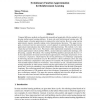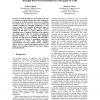325 search results - page 18 / 65 » Evolvable network architectures: what can we learn from biol... |
ICML
2010
IEEE
13 years 9 months ago
2010
IEEE
We introduce a novel active learning algorithm for classification of network data. In this setting, training instances are connected by a set of links to form a network, the label...
ML
2000
ACM
13 years 8 months ago
2000
ACM
We present an approach to inductive concept learning using multiple models for time series. Our objective is to improve the efficiency and accuracy of concept learning by decomposi...
CORR
2010
Springer
13 years 8 months ago
2010
Springer
Temporal difference methods are theoretically grounded and empirically effective methods for addressing reinforcement learning problems. In most real-world reinforcement learning ...
CIG
2005
IEEE
14 years 2 months ago
2005
IEEE
Several attempts have been made in the past to construct encoding schemes that allow modularity to emerge in evolving systems, but success is limited. We believe that in order to c...
DSOM
2000
Springer
14 years 27 days ago
2000
Springer
Abstract. Users need know nothing of the internals of distributed applications that are performing well. However, when performance flags or fails, a depiction of system behavior f...


